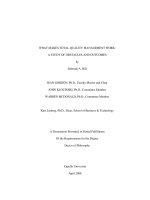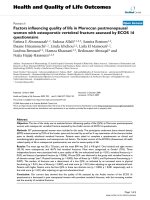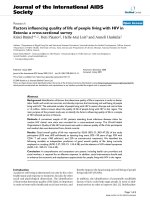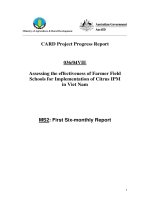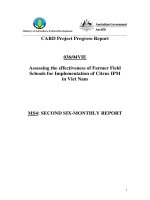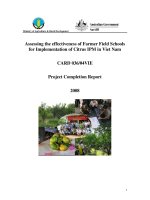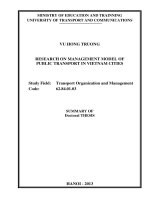Factors influencing quality of life, a study of brand communities in viet nam
Bạn đang xem bản rút gọn của tài liệu. Xem và tải ngay bản đầy đủ của tài liệu tại đây (530.55 KB, 66 trang )
UNIVERSITY OF ECONOMICS HO CHI MINH CITY
International School of Business
------------------------------
LE THI MUI
FACTORS INFLUENCING QUALITY
OF LIFE: A STUDY OF BRAND
COMMUNITIES IN VIET NAM
MASTER OF BUSINESS (HONOURS)
Ho Chi Minh City – 2018
UNIVERSITY OF ECONOMICS HO CHI MINH CITY
International School of Business
------------------------------
LE THI MUI
FACTORS INFLUENCING QUALITY
OF LIFE: A STUDY OF BRAND
COMMUNITIES IN VIET NAM
MASTER OF BUSINESS (HONOURS)
SUPERVISOR: Assoc. Prof. Nguyen Thi Mai Trang
Ho Chi Minh City - 2018
LIST OF CONTENTS
List of tables...................................................................................................................... 2
List of figures..................................................................................................................... 3
Introduction.......................................................................................................................4
Literature review................................................................................................................ 8
Brand community........................................................................................................8
Value co-creation practices and brand relationship quality.........................................8
Brand relationship quality and consumer hope.......................................................... 12
Consumer hope and quality of life............................................................................ 14
Methodology.................................................................................................................... 16
Design and Sample.................................................................................................... 16
Measurement............................................................................................................. 18
Data analysis and results.................................................................................................. 18
Testing the measurement model................................................................................. 18
Testing the hypothesis model..................................................................................... 24
Discuss and implications.................................................................................................. 25
Limitations and direction for future research................................................................... 29
Conclusion....................................................................................................................... 30
Appendix.......................................................................................................................... 31
References........................................................................................................................ 52
List of tables
Table 1: The profile of respondents in the study
Table 2: Cronbach’s Alpha for all constructs
Table 3: Pattern Matrix in EFA analysis
Table 4: Standardized CFA loadings of items
Table 5: Correlations of items
Table 6: Regression Weights in SEM analysis
Table 7: A again qualitative survey report
2
List of figures
Figure 1: Proposed research Model
3
Abstract
This research investigates the impact of value co-creation practices in online brand
community on quality of life by the mediating of brand relationship quality and
consumer hope. The research was designed for the sample size about 250
respondents in online brand communities such as Apple brand community for Iphone
fans, Channel brand community for perfume fans, 38 Degree flowers brand
community for flower fans and SamSung brand community for the fans of Galaxy
lines. The results indicate that it can be said that the existence of relationship between
two elements of value co-creation practices in online brand community including
impression management, brand use and brand relationship quality as well as the
presence of the relationship in series from brand relationship quality to consumer
hope and then quality of life. Finally, some implications are discussed to gain point
of view objectively about research results.
4
Introduction
The fourth industrial revolution has had a dramatically booming stage
in recent years and seems breaking most of traditional industries in
every country because the fact that the remarkable number of global
online retail sales was to increase from US$236 billion to US$521 billion
over five years, from 2007 to 2012, was estimated to reach $1248.7
billion in 2017 (Verma et al., 2016). Consumer have had awareness of
benefits of this channel such as great price and flexible time by the
significant increase in e-commerce platforms global (Denegri‐Knott,
2006; Nedergaard & Gyrd-Jones, 2013). The fact that it has changed
significant marketing industry, leading to a creatively online marketing
stage thanks to the unique aspect of social media and its huge spread
for revolutionizing marketing process (Hanna, Rohm, &Crittenden,
2011) and consumer behavior from absorbing information for making
purchase online (Mangold & Faulds, 2009; Powers, Advincula, Austin, &
Graiko, 2012). Otherwise, compared with the online ones, the other
benefits of social media based brand communities are the lower cost of
initiating these communities, higher reward, and the number of greater
reach because of normally using free the platforms (LaPointe,2012).
Accordingly, the rapidly popularizing of social networking technologies
has generated ideal circumstance including a new platform and
opportunities to retain existing members and attract new customers
for brand community (Kietzmann, Hermkens, McCarthy, & Silvestre,
2011).
5
Specifically, the concept of brand community is taken into as one of main
considerations in marketing field recently (Muniz & O’Guinn, 2001). When
researchers study initial about brand communities, online brand communities are
deemed as tools in order to build relationships between consumers and brands thanks
to corresponding internet condition (Schultz& Bailey, 2000). The brands and
consumers are provided many values such as sharing knowledge and engaging
supportive consumers by brand communities (Andersen, 2005), making strong
impression to customers on the brand features and stimulating their loyalty (Andersen,
2005; McAlexander et al., 2002), gaining valuable market data for development and
research (Von Hippel, 2005), and co-creating benefits with consumers (Schau, Muñiz,
& Arnould, 2009). Moreover, the brand community on social media help new
customers stimulate purchase intention by joining and participating in brand clubs and
associates (Algesheimer et al., 2005; McAlexander & Schouten, 1998). In conclusion,
it may be argued that brand community helps value co-creation practices to be more
convenient and efficient.
Customer- brand relationship that customers can create an active relationship with
brand is like building relationship with friends, which means brands are considered as
customer’s partners (Hudson et al., 2015). A study of individual relationships in
social psychology as well as personality presents the metaphor of brand relationship
(Breivik & Thorbjornsen, 2008; Smit et al., 2007). Customers participate in brand
relationships because of benefits from the meanings they gain into their life, not only
possessing well good brand with its function and utilitarianism but also more
6
psychological and emotional (Fournier, 1998). Thus, it possibly be claimed that brand
relationship quality interrelated obviously to brand community.
Although many previous researches point out that value co-creation practices have an
important influence on enhancing brand loyal (McAlexander et al., 2002; Muniz &
O’Guinn, 2001; Muniz & Schau, 2005; Habibi, Laroche, & Richard 2016), and
demonstrate how value co-creation practices influence brand relationships quality in
brand communities (Luo et al, 2015). However, individual quality of life concept have
not been mentioned while the previous studies present value co-creation practices in
brand community concept, moreover, those have not demonstrated the influence of value
co-creation practices on quality of life with the mediating of consumer hope.
Therefore, it may be extremely virtual to address the gap recognizing the worth of
consumer hope for mediating role because of providing insights into customer’s
perceptions as well as feeling in an online brand communities context (Raggio, Walz,
Godbole, & Folse, 2014). The purpose of this paper is to examine the impact of value
co-creation practices in online brand community on quality of life by the mediating of
consumer hope and then it is suggested suitable recommendations. The paper is
organized with the next section is literature review based on foundation of previous
research models tested in the research and followed by the right methodology, next
sections, the data analysis and results, and discussion and implications will be
indicated . Finally, the paper rounds off with limitation and direction for future
research and conclusions.
7
Literature review
Brand community
Brand community is defined as a “specialized, non-geographically bound community
and based on a structured set of social relations among admirers of a brand” (Muniz
& O’Guinn, 2001, p. 412), covering a huge community entire from virtual (Adjei,
Noble,& Noble, 2010) to undersized brand communities (Schouten,McAlexander, &
Koenig, 2007). In addition, brand communities are conducive to sharing of benefits
including information and experience; enhancing the band values (Muniz& O’Guinn,
2001), resulting in “co-creation and negotiation of meaning” (McAlexander et al.,
2002). That valuable knowledge make individual connect feeling insights among
members intje brand community (Kuo & Feng, 2013). On the other hand, shared
features are representative of communication that maintain meanings and
cultural norms, finally, obligations to society are a felt sense of responsibilities
for the member in community (Kuo & Feng, 2013).
Value co-creation practices and brand relationship quality
The co-creation of member benefits and community potential by variety activities
within a brand community is considered as value co-creation practices while members
in brand community create worthy thing for the brand or others in the community
(Schau et al., 2009). Furthermore, value co-creation practices is supported favorably
to implement by the platform of social network and make members and other
elements of a brand community obtain a high-context interaction, leading to reinforce
8
the brand relationship quality brand community (Muniz & O’Guinn, 2001). Moreover,
the progressive of value co-creation combination including series of particular
elements, such as “welcoming, empathizing, milestoning, documenting, evangelizing,
justifying, customizing, commoditizing and so on”, these are mainly led by four
elements: “social networking, community engagement, impression management and
brand use” (Schau et al., 2009). Thus, another research also demonstrates value cocreation practices has a positively influence on brand relationship quality (Habibi,
Laroche, Richard, 2016).
Social networking
Social networking including such practices as “welcoming, empathizing, and
governing” pertains to “creating, maintaining, and cementing ties” among brand
community members” (Schau et al., 2009). In addition, according to social capital
theory, the social networks and trustworthy relationships, and enhance the
togetherness will be established and strengthened propitiously by frequent
interpersonal interactions (Chang & Chuang, 2011; Lee, Kim, & Kim, 2012; Lee,
Xiong, & Hu, 2012), influence positively to the identification with the brand
(Algesheimer et al., 2005). For instance, other authors (Habibi et al.,2014) indicate
many cases welcoming a new member in communities on Facebook, or “like” and
“comment” their stories, and make direct conversations or make friend relationships
on social media, resulting in that the more committed the member is about the
rituals of the community, the more they would like to be involved in value cocreation practices. Therefore, it is hypothesized that
9
H1: Social networking in brand community related positively to brand relationship
quality.
Community engagement
According to the brand community theory (McAlexander et al., 2002; Schau et al.,
2009) community engagement is identified as regular activities including
“documenting, badging, milestoning and staking” that consumers share their
important milestone and evolve cohesive personal brand narratives, related to enhance
members' engagement in the community. Furthermore, members collaboratively build
social capital, for instance, concentrating on a specific thing of shared interest with
individuals or sharing unique experiences they gained about using the brand (Schau et
al., 2009). Otherwise, consumer’s experiences and knowledge in online brand
community are improved significant brand community by sharing photos, videos, and
text-based stories in their brand usage (Habibi et al., 2014; Zaglia, 2013). Therefore,
brand relationship quality will be stimulated by these reinforce members’ regular
engagement with the brand community. So another hypothesis is presented:
H2: Social networking in brand community related positively to brand relationship
quality.
Impression management
Next another element of value co-creation practices is impression management
including evangelizing and justifying (Schau et al., 2009). Previous researchers
presents the effort to create a favorable impression on outside of community brand
through conducting impression management practices of the brand community
10
members, they are ‘‘activities that have an external, outward focus on creating
desirable impressions of the brand, brand enthusiasts and brand community in the
social university beyond the brand community’’(Schau et al., 2009). In addition, other
research proves impression management is implemented in different ways, share
helpful items about the brand to be feel a strong sense of connectedness, obligations
to society as well as commitment to the rituals, and obtain participation in impression
management (Habibi et al., 2014). Since members define this community as part of
their self-identity (Algesheimer et al., 2005), it is every member’s duty to maintain
and increase a favorable image of the community among others, leading to affect
positively on brand relationship quality. Thus, another hypothesis is proposed that:
H3: Impression management in brand community related positively to brand
relationship quality.
Brand use
The last elements of value co-creation practices is brand use “including customizing,
grooming and commoditizing” that the activities that help individuals in brand
communities using effective brand, and enhance others members use brand, related to
“the member’s tendency to help other members with newer, improved and enhanced
ways to use the focal brand” (Schau et al., 2009). Furthermore, researchers determine
that interpersonal ties in a group are enhanced and the willingness to share
information and resources with other members is increased by shared consciousness,
to provide assistant and to commit to goals identified by the group (Walther, 1996;
11
Wellman, 1999). There is therefore significant increase in brand relationship quality
in online brand community.
H4: Brand use in brand community related positively to brand relationship quality.
Brand relationship quality and consumer hope
Brand relationship quality
“Brand relationship quality is defined as a customer-based indicator of the strength
and depth of the person-brand relationship” (Smit, Bronner, & Tolboom, 2007), and
consumer personality characteristic is projected onto the brands when describing
them (Phau and Lau, 2001). Otherwise, brand relationship quality is considered as
“the degree to which the consumer views the brand as a satisfactory partner in an
ongoing relationship” (Algesheimer et al., 2005, p.23). A research indicates that there
is existence of brand-customer relationship since the metaphor of brand relationship is
originated from interpersonal relationship (Breivik and Thorbjornsen, 2008). The
meanings customers obtain when they participate in brand relationships are function
and utilitarianism; others are more psychological and emotional (Fournier, S., 1998).
According to Fournier (1994, 1998a), brand relationship quality is a huge concept
including several relationship elements such as “affective and socio-motive
attachments (e.g., love/passion, self-connection, nostalgia, etc.)”.
Consumer hope
In terms of hope, it is one of the key cognition that “involve both will (motivation)
and way (action plans) components in explaining customers’ online purchase and
repurchase behaviors” (Snyder et al, 1991), “focus on participants’ levels of hope for
12
successful performance of a particular task or goal” (Snyder, 2000). The relationship
of hope and customer choices have dedicated in some researchers (Poels and
Dewitte, 2008; Kim et al., 2012). Others have identified there is a positive
relationship of hope with advertising and product evaluation, choice (Macinnis and
De Mello, 2005; Poels and Dewitte, 2008). When and how customers’ perceptions
are responded by consumer hope’s psychological, and converted to a more specific
relationship (from a customer point of view) and performance outcomes (from a
brand point of view) both for customers and the brand (Syed Muhammad Fazal-eHasan; Hormoz Ahmadi; Gary Mortimer; Martin Grimmer; Louise Kelly, 2018).
Therefore, it can be said that consumer hope is comprehended as consumer belief in
gaining many benefits from brand community and quality products.
Brand relationship quality and Consumer hope
Previous research suggests that the positive influence of customers’ perceptions of a
brand's value on their motivating level and behavior towards the purchase of the brand
(Bowlby, 1977; Bretherton, 1985; Feeney and Noller, 1990), giving to that when
customers have significant brand relationship quality, they will be motivated by their
consumer hope for purchase intention. Moreover, the brand value co-creation through
“the interactivity, reliability, usability, content quality and the security of the online
brand's platform” may be supportive dramatically for online purchase where the most
digital product without physically ones, perception of brand value (quality) may be
built (Chang and Chen, 2009). Likewise, “customer perceived brand value contributes
in terms of promoting the physical and psychological well-being of a customer –
13
which in turn improves their levels of motivation (will) and the number of alternatives
(way) they undertake to attain their purchase-related goals” (Feeney and Noller, 1990;
Goldberg, Muir and Kerr, 2013). Therefore, when customers gain many benefits from
online brand community with brand relationship quality enhanced by every members
of the online community help them pay more attention as well as attaint consumer
hope in near future, they are likely to experience hope for continuing positive
relationships between the brand and themselves. Thus, it is hypothesized that:
H5: Brand relationship quality in brand community related positively to consumer
hope.
Consumer hope and quality of life
Quality of life
In terms of quality of life, it has been admitted that quality of life is the huge concept
approached in a variety of aspects (Lee et al. 2002; Vaez, Kristenson, and Laflamme
2004). It can be defined as the overall satisfaction with life (Vaez, Kristenson, and
Laflamme 2004). In term of the satisfaction approach for quality of life, there are
many aspects taken into consideration such as relationship quality satisfaction,
consumer satisfaction and job satisfaction, community value satisfaction.
Consumer hope and quality of life
The research on the psychology of hope has demonstrated that “hope requires
individuals to employ successful agency (i.e., goal directed energy) and pathways (i.e.,
plans to meet the goals)” (Snyder et al., 1991; Rego, Sousa, Marques and Cunha,
2014). Another research states that helps individuals achieve goals, create power for
14
promotion in the life (Snyder et al., 1991). Furthermore, as presented in the above
part of consumer hope, it is available for positive relationship of hope and customer
choices (Poels and Dewitte, 2008; Kim et al., 2012) as well as advertising and product
evaluation and choice outcomes (Macinnis and De Mello, 2005; Poels and Dewitte,
2008). According to social exchange theory, customers will feel obligated to
reciprocate and commit to a relationship when they benefit from others. When the
relationship commitment is strong, they tend to trust the organization and feel more
satisfied with what the organization has promised. Because consumer hope may be
related to optimism, belief, motivation help members obtain interested value as well
as benefit satisfaction from on brand community, it can be reinforce quality of life.
Thus,
H6: Consumer hope in brand community related positively to quality of life.
Figure 1: Proposed research Model
15
Methodology
Design and Sample
To examine the proposed research model as well as explain the effect of value create
practices in brand community on quality of life, a survey was implemented for
interested brand communities in Viet Nam. However, in order to improve
respondent’s quality and customers’ focus on their choice of brands, the research was
designed a screening question was to exclude respondents having not ever followed
any brand community, and a multiple choice for the most usually followed brand
community.
First of all, qualitative research were carried out in-depth interviews on one-to-one
basic with fifteen respondents for ensuring that were applicable for Viet Nam context
in spite of the available mention of measures in the literature, leading to uncover
underlying motivation, prejudices, and attitudes of respondents as well as allow more
in-depth probing of an issue that is raised for more information. Next step was
quantitative research, this study was used key method that was online survey designed
in Google form to access respondents via e-mail or an individual message by social
network with introducing the objectives of the study and an embedded link to the
survey.
The research was designed for the sample size about 250 respondents in online brand
communities such as Apple brand community for Iphone fans, Channel brand
community for perfume fans, 38 Degree flowers brand community for flower fan
and SamSung brand community for the fans of Galaxy lines. The suitable reason for
16
choosing those was the results of the qualitative research showed that most
members had responses about the popularity of them as the most usually followed
brand communities. Then, the data was cleaned and remained 239 usable ones. In
particularly, the detail infographic was showed in the following table.
Table 1: The profile of respondents in the study
Characteristics
Gender
Age (in years)
Education
Income
The most followed brand
community
Time to follow the above brand
community
17
Measurement
The multiple item-scales were uses for construct measurement. Specifically, social
networking, community engagement, impression management, brand use were
respectively measured by 6 items, 7 items, 6 items, 7 items borrowed from Habibi,
Laroche and Richard (2016). Brand relationship quality was measured by 3 items
borrowed from Algesheimer, Dholakia and Herrmann (2005). Consumer hope was
measured by 3 items borrowed from Elliot and Murayama (2008). Quality of life was
measured by 3 items borrowed from Peterson, Ekici and Hunt (2010). The data was
gathered and analyzed by SPSS 16.0 software and Amos 20 to examine the research
hypotheses. Then, the data analysis included: (1) descriptive statistics, (2) reliability,
validity and correlation analysis, (3) regression analysis, and (4) analysis of variance.
In addition, seven-point likert-type scale, anchored by 1 (strongly disagree) and 7
(strongly agree) was used for all items in this study. Otherwise, independent variables
are social network practices, community engagement practices, impression
management practices and brand use practices, and mediators is brand relationship
quality, consumer hope, and dependent variable is quality of life.
Data analysis and results
Testing the measurement model
Scale reliability and factor analysis: The first step of reliability and factor analysis
was cronbach’s alpha analysis by SPSS 16 software with the proposed values of 0.6
(Cronbach, 1970) for each construct. Particularly, all the Cronbach’ alpha value of the
factors exceeds proposed values in the following table.
18
Table 2: Cronbach’s Alpha for all constructs
Factors
Social Network
Community Engagement
Impression Management
Brand Use
Brand Relationship Quality
Consume Hope
Quality of Life
After that, explore factor analysis was conducted in order to find out whether items
obtain convergent validity and discriminant validity by Principal Axis Factoring
Extraction Methodand Rotation Method Promax with factor loading above 0.50
(Steenkamp & van Trijp, 1991). As presented in the following output, the following
factors achieved the given condition with factor loading over 0.5.
19
Table 3: Pattern Matrix in EFA analysis
IM3
IM6
IM4
IM5
IM2
IM1
QOL1
QOL2
QOL3
CH2
CH3
CH1
BU5
BU4
BU2
BU7
BRQ2
BRQ1
BRQ3
SN2
SN3
SN4
CE1
CE2
CE4
20
Then, confirmatory factor analysis was implemented by Amos 20 software in order to
measure model fit. The final CFA model received an acceptable fit to the data with
the results exceed proposed values because of Chi-square/df = 1.341 (< 3); p-value
=
.000 (<0.05); GFI = .900 (<0.9); CFI = .949(<0.9); TLI = .940 (<0.9) and
RMSEA
=
.038 (<0.05) (Bentler, 1990).
The scale composite reliability (CR) and AVE were calculated in the Table 4. In
particularly, reliability estimate of factors were higher 0.7 demonstrating good
reliability, others between 0.6 and 0.7 may be acceptable, this pointed out existence of
internal consistency and the same latent construct was represented consistently by all
the measures (Hair, Black, Babin, & Anderson, 2010). Next step was comparing AVE
value for any two construct with the square of their correlation estimate, this proposed
that the squared correlation estimate should be smaller than AVE value for good
proves of discriminant validity (Hair, Black, Babin, & Anderson, 2010). Obviously,
all AVE value in table 4 were higher than all the squared correlation estimates in table
5, this explained the individual measured items were represented by only one talent
construct.
21
Table 4: Standardized CFA loadings of items
Standardized
CFA
Loadings
Impression_Management
It is important for members to show why they love this brand
Members of this brand community actively engage in discussions
to justify their affinity towards this brand
It is important for members of this brand community to create
a favorable impression of this brand for other members
Members of this brand community positively compare this brand
with other competing brands
Members of this brand community share good news about this
brand through posts, photos, events, etc
Members of this brand community actively encourage others to
adopt this brand
Quality of life
Conditions of my life are excellent
I am satisfied with my life
I have gotten the important things I want in life
Consumer Hope
I hope that the brand I purchased online will benefit me
I hope the brand I purchased online will help me pursue my goals.
I hope the brand I purchased online leads to my success
Brand Use
Members of this brand community share their experiences about
their successful and UN-successful attempts at customizing its
products Members share their market knowledge to enhance the
usage of the brand
Caring for the brand is a value in the brand community
Members of this brand community are concerned with the optimal
uses of this brand
Brand Relationship Quality
This brand says a lot about the kind of person I am
This brand's image and my self-image are similar in many respects.
This brand plays an important role in my life.
Social_Network
This brand community emotionally supports its members when
they need it
I received special treatment after I became a member of this
brand community
This brand community recognizes special occasions for me and
sends me personal greetings
Community_Engagement
This brand community has several specific domains to which
members can contribute
There are many pages on social media that are devoted to a
specific aspect of this brand
Seminal experiences with the brand are highly valued in the
brand community
CR
AVE
.801
.404
.870
.692
.771
.533
.723
.396
.725
.471
.676
.417
.627
.364
.691
.672
.601
.684
.580
.572
.902
.823
.764
.848
.702
.623
.626
.699
.608
.579
.789
.655
.600
.727
.692
.492
.637
.473
.680
22



